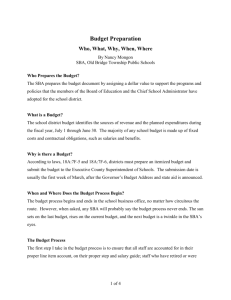Dealer Floor Plan Financing
advertisement
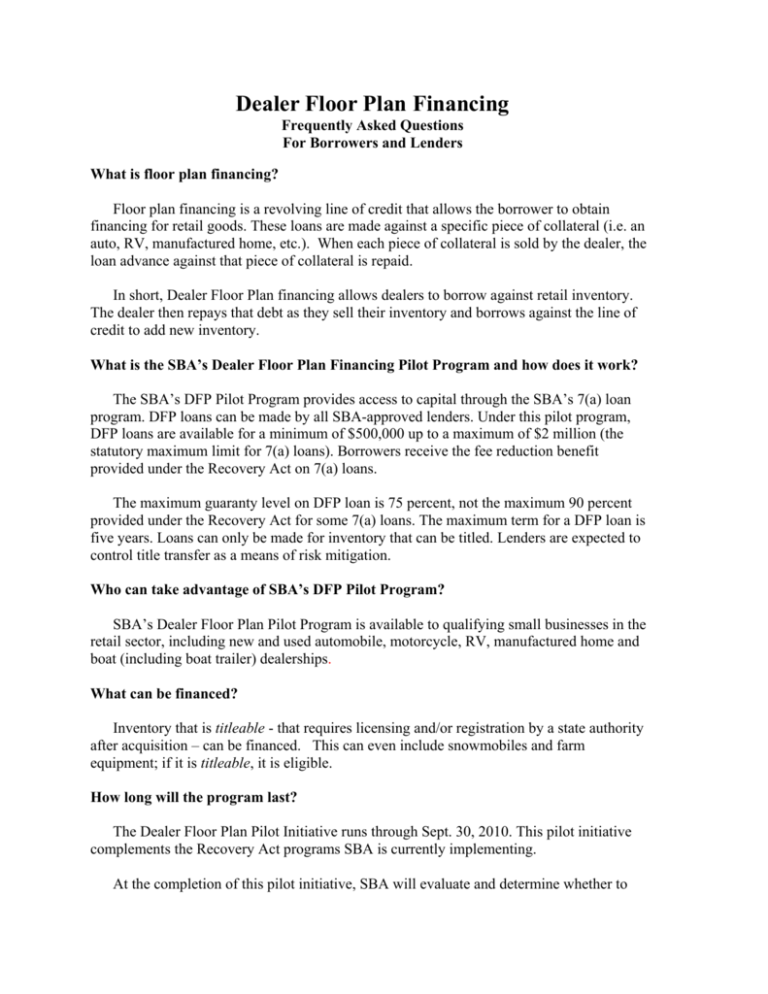
Dealer Floor Plan Financing Frequently Asked Questions For Borrowers and Lenders What is floor plan financing? Floor plan financing is a revolving line of credit that allows the borrower to obtain financing for retail goods. These loans are made against a specific piece of collateral (i.e. an auto, RV, manufactured home, etc.). When each piece of collateral is sold by the dealer, the loan advance against that piece of collateral is repaid. In short, Dealer Floor Plan financing allows dealers to borrow against retail inventory. The dealer then repays that debt as they sell their inventory and borrows against the line of credit to add new inventory. What is the SBA’s Dealer Floor Plan Financing Pilot Program and how does it work? The SBA’s DFP Pilot Program provides access to capital through the SBA’s 7(a) loan program. DFP loans can be made by all SBA-approved lenders. Under this pilot program, DFP loans are available for a minimum of $500,000 up to a maximum of $2 million (the statutory maximum limit for 7(a) loans). Borrowers receive the fee reduction benefit provided under the Recovery Act on 7(a) loans. The maximum guaranty level on DFP loan is 75 percent, not the maximum 90 percent provided under the Recovery Act for some 7(a) loans. The maximum term for a DFP loan is five years. Loans can only be made for inventory that can be titled. Lenders are expected to control title transfer as a means of risk mitigation. Who can take advantage of SBA’s DFP Pilot Program? SBA’s Dealer Floor Plan Pilot Program is available to qualifying small businesses in the retail sector, including new and used automobile, motorcycle, RV, manufactured home and boat (including boat trailer) dealerships. What can be financed? Inventory that is titleable - that requires licensing and/or registration by a state authority after acquisition – can be financed. This can even include snowmobiles and farm equipment; if it is titleable, it is eligible. How long will the program last? The Dealer Floor Plan Pilot Initiative runs through Sept. 30, 2010. This pilot initiative complements the Recovery Act programs SBA is currently implementing. At the completion of this pilot initiative, SBA will evaluate and determine whether to extend the pilot, terminate the pilot or make it a permanent part of SBA’s lending programs. Why is there a minimum and maximum loan amount for DFP loans? Based on our discussions with the various dealership associations, we believe that the limits set for this pilot program provide a range that are beneficial to dealers who are in need of this type of financing at this time. Under the 7(a) program loan amounts are set at the legal maximum of $2 million. The minimum loan amount (set at $500,000), along with limiting the DFP loans to only inventory that can be titled, are steps taken to help reduce risk for lenders and SBA. Why is this only a pilot initiative? SBA has not traditionally offered loans for floor plan financing, so the pilot program will allow the agency to determine the effectiveness of the program and determine whether it should be made a permanent part of SBA’s lending programs. Why is SBA offering a floor plan financing program now? A number of large floor plan lenders have exited the market recently due to their inability to sell the loans into the secondary market. This has decreased access to capital for a number of viable small business owners in the retail sector. Since many SBA lenders already have other credit relationships with these retailers, this program allows these lenders to prudently extend this critical line of credit as a lifeline to these dealerships in these tough economic times. It will help restore cash flow and, in turn, save jobs. Isn’t this just throwing money after businesses that are likely going to close anyway? No. Loans are made through SBA lenders to creditworthy dealerships that meet the lender’s and SBA’s requirements, demonstrate sound finances and have a viable business plan. In each case, the lender has extensive capital at-risk as these loans must be held on the lender’s books. How many DFP loans do you expect to be made under this program? We know that there has been a lot of interest in a dealer floor plan financing program, and we expect a fairly high demand for this line of credit. We also expect a ramp-up period as lenders become more familiar with the program and begin to issue loans. Is SBA going to be able to make enough loans to help this industry? SBA lenders are already very involved with the auto, recreation vehicle, boat and other industries that will benefit from DFP. Since 2000, SBA lenders have extended more than 4,250 7(a) and 504 loans worth $1.125 billion to borrowers in these industries. We believe that the DFP pilot program will provide the access to capital many viable auto dealerships need at this critical time as they go through the transition brought on by larger changes within their industry. The DFP financing will also help dealerships in a number of other industries that are facing restricted access to capital. Because of the severe decrease of dealer floor plan financing over the last several months, each of these loans most likely will keep open a viable business that would have otherwise closed. This pilot initiative also gives SBA the opportunity to assess and evaluate DFP financing and then determine whether or not to extend the pilot initiative. Isn’t floor plan financing available through GMAC, which has received significant financial help from the federal government already? If so, why is it necessary for SBA to offer this program? GMAC will primarily be assisting GM and Chrysler dealers that have been slated to continue their franchise after the announced downsizing. There are other GM and Chrysler dealers that are viable but have lost their access to floor plan financing when their lenders stopped making those loans. In addition, some of the dealers slated for downsizing may still be viable as used car, service and repair providers. In fact, the majority of new car dealership profitability comes from the parts and service side of the business. What about the dealerships that Chrysler and GM have already cut? Floor plan financing won’t help them? Across the country, small businesses in the auto-related sectors, from dealerships to parts suppliers and others, are going through a transition. In the case of dealerships, some will continue to be dealerships. Others will transition to other business models and offer different products and services. The SBA offers an array of loan programs and other tools that may help these small businesses through this transition and these tough economic times. DFP financing is just one of those tools. Whether it’s another loan program or technical assistance to help them through this transition, SBA stands ready to work with small business owners and be the real partner they need at this critical time. Why hasn’t SBA offered floor plan financing in the past? DFP is a specialized type of revolving credit. Historically, SBA loan programs were term oriented and only recently have revolving credit products been offered. In addition, SBA previously serviced and liquidated most of its loans and never had the resources to properly manage the collateral necessary for a successful DFP program. SBA has now delegated almost all of these functions to our lending partners making a DFP initiative viable. What is the maximum advance rate on these loans? New auto and light truck inventory can be financed up to 90 percent of the wholesale price and all other inventory can be financed up to 80 percent. A lender may offer a higher advance rate, but its SBA guarantee will be based upon the SBA maximum. What is the maximum interest rate? The maximum interest rate is the same as that for standard 7(a) loans with a maturity of less than seven years. Lenders can charge one of the authorized SBA base rates (such as Prime), plus up to 2 ¼ additional points. What fees can lenders charge on these loans? Lenders may charge the same fees as are allowed in the standard 7(a) program with the exception of the extraordinary servicing fee. Under the DFP Pilot Program, SBA allows lenders to charge more than 2 percent for servicing these lines of credit, as long as the fee is reasonable and prudent in light of the extraordinary effort required. In addition, if the lender currently provides floor plan financing to its customers, the lender may not charge higher fees for its SBA-guaranteed floor plan lines of credit than it charges for its similarly-sized, non-SBA guaranteed floor plan lines of credit. May lenders use their delegated PLP authority to approve DFP loans? Yes, except for the first loan approved for each lender and once lender policy have been reviewed by OCRM, and for Less Experienced Floor Plan Lenders. Less Experienced Floor Plan Lenders are defined as those lenders with less than $15 million in floor planning portfolio, or who have been making floor plan lines less than five years.
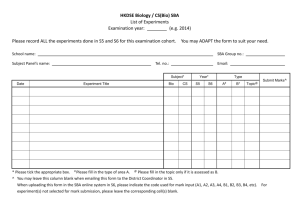
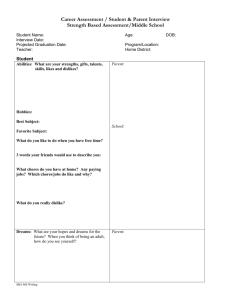

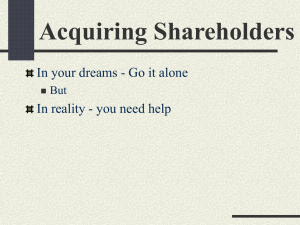

![[07]. Sources of Capital](http://s2.studylib.net/store/data/005505954_1-911bc72c2d6c6cd967dc43c95f25b7bd-300x300.png)
